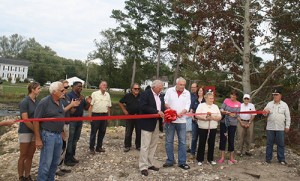
BISHOPVILLE — Roughly a decade since its inception, the Bishopville Pond Dam removal project was celebrated last week by environmentalists, neighbors and elected officials as it finally nears the finish line.
The project, which has been on the books for nearly 10 years, includes replacing the existing Bishopville Dam on the Bunting Branch of the St. Martin’s River and creating a series of weirs, or “fish ladders,” to aid in the migration of several species native to the area. Ultimately, the dam replacement and the construction of the step pools are expected to vastly improve water quality in the impaired waterway and create a natural transition from the tidal to non-tidal sections of the pond.
With the majority of the project now completed, representatives from the Maryland Department of Natural Resources (DNR), the Maryland Coastal Bays Program, the Bishopville-St. Martin’s Neck Community Association, along with State Senator Jim Mathias (D-38), and Worcester County Commission President Jim Bunting, who represents the area, gathered at the site last weekend for a ribbon-cutting ceremony to commemorate the near-completion of the long-awaited project.
“The ceremony was a wonderful demonstration of how important the dam removal has been to Bishopville,” said Catherine Shanks, Director of DNR’s Habitat Restoration and Conservation Division. “A lot of people came out to celebrate the project, which is almost complete. The new design meets both the needs of the community and the environment and will persevere time.”
The project included the replacement of the long-standing four-foot high sheet metal dam with 635 linear feet of re-established stable stream channel and wetland habitat. The project, which spanned a decade and battled some regulatory resistance and funding issues along the way, cost $1.5 million, over half of which was funded by the DNR through the Chesapeake and Atlantic Coastal Bays Trust Fund.
Located on Bunting’s Branch, a tributary of the St. Martin’s River, the project was a collaboration of state and local agencies, the MCBP and citizen volunteers. The steel portion of the dam has been removed and replaced with a series of pools, runs and weirs to create a more natural waterway with improved ecosystem functions, including fish passage and nutrient pollution reduction.
In addition, the long-neglected area has now been transformed and lined with 1,000 trees that were planted by local volunteers, including Salisbury University students and Maryland Conservation Corps crews. The trees, mainly Atlantic white cedars, will stabilize the ground around the site and help filter storm water. MCBP Science Coordinator Roman Jesien said the project was complicated but comprehensive.
“The restoration isn’t just dumping rocks and sand and walking away,” he said. “This is an innovative ecosystem restoration that allows access at the same time. We’d like to use the new area as a classroom to demonstrate the way things should be done.”
Due to the restoration efforts, seven miles of creek are now accessible spawning and nursery habitat for key fish species, including blue back herring and alewife as well as American eel. Water quality monitoring conducted by the MCBP and the DNR during construction has already revealed a 20-percent increase in dissolved oxygen downstream of the project. Future monitoring is expected to reveal more successes in fish passage ability and water quality improvements. While the project has obvious ecologic benefits, it should be enjoyed by the residents in the area as well.
“Without the support of the local residents, the Bishopville community and the Maryland Coastal Bays Program, this project would have never happened,” said the DNR’s Kevin Smith, who was a driving force behind the dam restoration. “I hope the residents here get an opportunity to enjoy the benefits of this project and maybe even catch a fish or two.”

